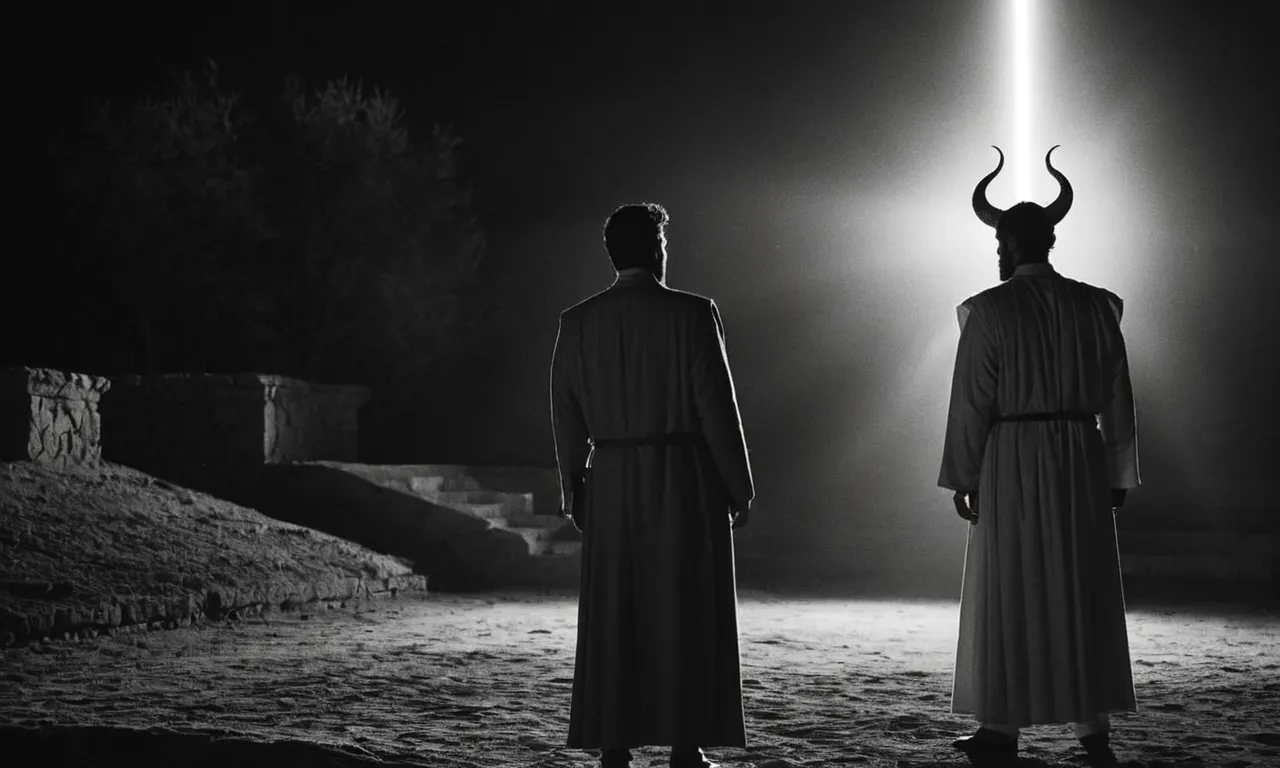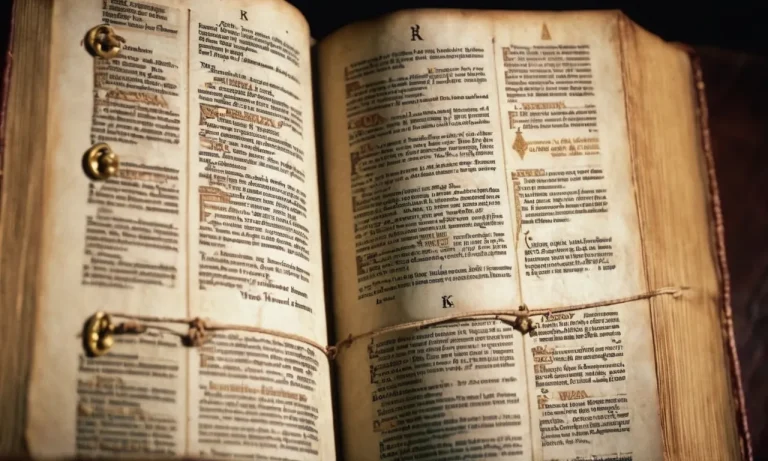Who Is Lucifer’S Brother In The Bible?
The story of Lucifer and his fall from heaven is one that has fascinated people for centuries. His origins and relationship to other angels have been debated by theologians and scholars alike. In this comprehensive guide, we will examine who exactly Lucifer’s brother is according to biblical texts and interpretations.
If you’re short on time, here’s a quick answer: According to most common interpretations, Lucifer’s brother is the archangel Michael.
Introducing Lucifer and His Origins
Lucifer’s Names and Roles
Lucifer, whose name means “morning star” or “shining one,” was originally an angel created by God. Described as the “anointed cherub” in Ezekiel 28:14, Lucifer was beautiful, intelligent, and held a high position in heaven. According to Isaiah 14:12, Lucifer is referred to as “Day Star, son of Dawn.”
These passages indicate that before his fall, Lucifer was appointed by God to be one of the angelic leaders.
Some scholars believe the description of the King of Tyre in Ezekiel 28 actually symbolically references Lucifer and his story. This is due to the language used that mirrors language elsewhere referring to Satan being cast of out heaven.
If this theory is accurate, it means Lucifer was adorned with precious stones, had access to the holy mountain of God, and was blameless in his ways from the day he was created.
Lucifer’s Fall from Heaven
Although Lucifer was originally righteous, Ezekiel 28:15 states that “unrighteousness was found” in him. Isaiah 14:13-14 describes Lucifer being motivated by pride, ambition, and a desire to set his throne above other heavenly beings to try to become like God Himself.
This prideful rebellion led to violent conflict in heaven.
Revelation 12 speaks of the Archangel Michael waging war against the dragon (identified as Satan) and the fallen angels who followed him. As result, Lucifer and the other rebellious angels were defeated and thrown down to earth.
Lucifer had allowed his beauty and intelligence to fuel greater pride, leading to corruption and a lust for more power. Thus the privileged cherub named Lucifer fell from heaven and became Satan.
His story serves as a warning to all human leaders. While beauty, intelligence, and rank should be used to honor God and serve others with humility, Lucifer’s example shows how these qualities can sometimes foster destructive tendencies toward greed and self-aggrandizement instead.
This cautionary tale in the Bible about the most perfect angel turned evil reminds us that no one, no matter how talented or favored, is beyond falling into sin when pride and ambition rule the heart.
Archangel Michael in the Bible
Michael’s Names and Roles
The archangel Michael is one of the most prominent figures in the Bible and later theological traditions. His name first appears in the Old Testament Book of Daniel, where he is called “one of the chief princes” and “the great prince who stands guard over your people” (Daniel 10:13, 12:1).
The meaning of his name in Hebrew is “Who is like God?” indicating his role as a protector of God’s people.
Throughout the Bible, Michael is portrayed as a warrior-prince leading God’s angelic army against evil forces. In the New Testament Book of Revelation, Michael and his angels wage war against Satan and his demons, driving them out of heaven (Revelation 12:7-9).
His supreme status as a commander of the heavenly hosts is confirmed by later Christian and Jewish writings.
Some other key responsibilities associated with Michael include:
- Watching over and championing Israel (Daniel 12:1)
- Leading departed souls to their final destinations after death (Jude 1:9)
- Interceding for mankind before God’s throne (Revelation 8:2)
So Michael fills diverse roles as a spiritual warrior, guardian angel, psychopomp, and heavenly intercessor across biblical and extra-biblical texts.
Michael in Relation to Lucifer
Michael is most famously connected to Lucifer (Satan) in theological traditions about angelic rebellions.
Though the Bible does not provide details on Lucifer’s identity, later interpretations equate him with a rebellious “morning star” who sought a position higher than God’s throne (Isaiah 14:12-15). Christian theology associates this being with the serpent who tempted Adam and Eve (Genesis 3) and identifies him with Satan, the “accuser” who tests human faithfulness (Job 1-2, Zechariah 3:1-2).
The archangel Michael leads the heavenly hosts against Satan’s rebellion in Revelation 12:7, casting the demons down to earth. This cosmic battle between Michael and Satan as opposing leaders of angels/demons has captured imaginations for millennia.
It has spawned abundant speculations in religious writings and artworks, fictional tales, and New Age movements about their continuing rivalry and the end times.
While details vary, a core theme across Judeo-Christian history is Michael loyally upholding God’s sovereignty against rebellious, prideful beings like Satan. Their cosmic struggle encompasses spiritual warfare across ages, though the Bible promises Michael and God’s forces will ultimately triumph.
Are Lucifer and Michael Really Brothers?
Interpretations of Their Relationship
There has been much debate among biblical scholars about whether the fallen angel Lucifer and the archangel Michael are actually siblings. Some point to passages that seem to indicate they are brothers, while others argue the text is more allegorical. Here are the key perspectives:
Debates Among Scholars
There are good arguments on both sides of this debate. Here are some of the perspectives from key theological circles:
So there are reasoned cases to be made either way. For an insightful discussion from both sides, see the article at The Gospel Coalition.
Lucifer and Michael as Adversaries
Their Battle in Revelation
The book of Revelation describes a great war in heaven between the archangel Michael and Satan, who is identified as “the ancient serpent called the devil, or Satan, who leads the whole world astray” (Revelation 12:9).
In this passage, Satan is defeated in heaven and cast down to earth along with his angels (Revelation 12:7-9). This likely refers to Satan’s original rebellion long before human history when he was cast out of heaven as a fallen angel.
Later in Revelation, it describes how Michael the archangel leads an army of angels against Satan and his forces: “Then war broke out in heaven. Michael and his angels fought against the dragon, and the dragon and his angels fought back.
But he was not strong enough, and they lost their place in heaven” (Revelation 12:7-8). Michael is portrayed as a warrior-prince leading God’s angelic army against the dragon (identified as Satan) and defeats him in battle.
This defeat of Satan by Michael fulfills a prophecy in the book of Daniel: “At that time Michael, the great prince who protects your people, will arise. There will be a time of distress such as has not happened from the beginning of nations until then.
But at that time your people—everyone whose name is found written in the book—will be delivered” (Daniel 12:1). Michael is the protector of God’s people and the defeater of Satan.
Michael Casting Lucifer from Heaven
The casting down of Satan from heaven by Michael the archangel is described in Revelation 12:7-9, but the original fall of Satan is not described in detail in the Bible. However, later Jewish and Christian traditions elaborate on the casting out of Satan from heaven.
According to these traditions, Satan was originally a beautiful and powerful archangel named Lucifer who rebelled against God out of pride. His rebellion was thwarted by the archangel Michael, who commanded the loyal angels against Lucifer and his followers.
After a climatic battle, Michael defeated Lucifer and cast him out of heaven into hell.
One common account describes Lucifer as the highest archangel who wanted to seize the throne of God for himself. When Michael ordered him to obediently serve God, Lucifer refused and persuaded a third of the angels to join him in rebellion.
But Michael and the good angels defeated them in a primeval battle and expelled Lucifer from heaven.
Though the name “Lucifer” does not appear in Revelation 12, Isaiah 14:12 contains a prophetic reference to Lucifer’s fall: “How you have fallen from heaven, morning star, son of the dawn! You have been cast down to the earth, you who once laid low the nations!”
This verse is interpreted as a metaphor for Satan’s rebellion and defeat by Michael the archangel.
Theological Importance of Lucifer and Michael
Symbolism in Their Relationship
Lucifer, often equated with Satan, and Michael the Archangel have a symbolic relationship in Judeo-Christian theology. Though once brothers, Lucifer’s rebellion and fall from heaven pitted them against one another as cosmic adversaries.
Their struggle represents larger themes of good vs evil, obedience vs rebellion, and the battle for human souls.
As Christianity’s highest-ranking angel, Michael defends goodness and God’s reign. He led the heavenly hosts who cast Lucifer out of heaven for his pride and ambition. Lucifer’s descent into Satan and ruler of hell signifies the darkness that results from forsaking God’s light.
Michael and Satan’s rivalry symbolizes humanity’s internal battle between following divine will or succumbing to worldly temptations.
Some key lessons emerge from Michael and Lucifer’s symbolism:
- Pride and ambition risk separating us from God’s grace
- There are cosmic forces of good and evil at work for human souls
- Each person must choose who to follow – God or Satan
- Staying on the “narrow path” requires spiritual discernment and discipline
Though opponents, Lucifer and Michael share an origin story highlighting core aspects of Judeo-Christian theology – freewill, sin, redemption, obedience, and the spiritual struggle.
Lessons for Followers of Christianity
For Christians, the symbolic relationship between Michael and Lucifer carries several key lessons:
- No one is above temptation – Lucifer was an exalted angel who fell prey to pride and envy of God’s power. This warns believers that no one, no matter how holy, is above the ability to sin when one strays from humility and trusting God.
- There are cosmic realities beyond the visible world – The story illustrates invisible realms where angelic beings influence human events. It hints at deeper dimensions where an ongoing battle for souls unfolds.
- Spiritual growth requires resistance to evil – Lucifer descends into outright evil after rebelling against God’s authority. His corruption into Satan shows how sin breeds further darkness when left unchecked. Believers must actively resist worldly temptations that oppose God’s way.
- Salvation depends on siding with God against evil forces – Michael’s triumph over Satan’s rebellion affirms God’s sovereignty over all. The message is that those who stand with God will overcome the darkness in the end. Our salvation thus requires aligning with heaven in spiritual warfare.
Ultimately, the age-old struggle between Michael and Lucifer represents the battlefield within every human heart. Each of us must choose whether to follow those angelic influences drawing us toward the light or the darkness.
That is why their symbolic relationship still carries such theological importance today.
Conclusion
In the end, while the Bible does not explicitly state that Lucifer and Michael are brothers, many theological interpretations over the centuries have pointed to them being sibling archangels. Their subsequent adversarial relationship as Michael casts Lucifer from heaven has become an iconic tale of good vs. evil.
Through examining the origins and biblical mentions of these two figures, we gain insight into the foundations of the Christian tradition.








